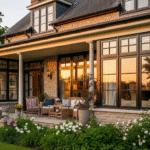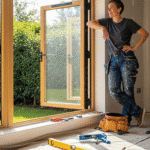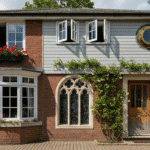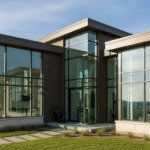Thinking about replacing your windows? Smart move. Quality, energy-efficient windows make your home look better, feel better, and sell better. Here’s how—and what to choose to get the biggest return.
At a glance (benefits you’ll notice fast)
Lower heating and cooling costs
Fewer drafts and hot/cold spots
Quieter rooms and better sleep
Stronger curb appeal and buyer interest
UV protection that helps prevent fading
Easier operation and cleaning
Less condensation and moisture damage
Modern locks and laminated glass options for security
Long warranties; potential rebates or incentives
How new windows add home value
1) Curb appeal that shows in photos and appraisals
Fresh sightlines, slimmer frames, and updated colors (black/bronze/wood-look) modernize a façade immediately. Appraisers and buyers factor visible updates—and documented efficiency—into value.
2) Documented performance buyers want
NFRC/ENERGY STAR® labels, transferable warranties, and low-maintenance materials reduce buyer risk. Energy features (Low-E, argon gas, warm-edge spacers) are easy to explain during showings.
3) Marketability and time-to-sell
“New windows” is a top line in listings. They signal fewer near-term expenses for the next owner, helping homes show better and sell faster.
How new windows improve comfort
Even temperatures, fewer drafts
Custom sizing + multi-point weatherstripping + insulated frames stop air leaks that old units struggle with.
Noise reduction
Double/triple panes and laminated glass dampen traffic, lawn equipment, and neighborhood noise.
Daylight without the heat
Low-E coatings admit natural light while reflecting unwanted infrared heat—brighter rooms with less glare.
UV protection
Modern coatings block the majority of UV that fades flooring, fabrics, and artwork.
Lower condensation
Warm-edge spacers and improved seals keep interior glass surfaces warmer, reducing moisture and mildew risk.
What makes a window energy-efficient?
Frame materials: Vinyl and fiberglass/composite insulate well; wood-clad gives a premium interior with protected exteriors.
Glazing: Double or triple panes with Low-E coatings and argon/krypton gas fills.
Spacers: Warm-edge technology reduces edge heat loss and condensation.
Air sealing: Multiple weatherstrips and compression seals—especially on casements/awnings.
Professional installation: Correct flashing, sill pans, and foam seals are essential for performance.
Key ratings to check (NFRC label):
U-Factor (insulation): lower is better.
SHGC (sun heat control): choose lower for hot, sunny climates; balanced for mixed climates.
VT (visible light): higher lets in more daylight.
Air Leakage (AL): lower means fewer drafts.
Picking the right style (function + look)
Casement: Hinged, crank-out; top air sealing and excellent ventilation.
Awning: Top-hinged; vent in light rain; great for bathrooms.
Double-Hung: Classic look; both sashes open/tilt for cleaning.
Slider: Wide views and simple operation; great for patios.
Picture (fixed): Maximum efficiency and daylight; pair with operable flanks.
Bay/Bow: Adds dimension and seating nooks; strong curb appeal.
Specialty shapes: Arches/circles for design statements; often fixed.
Tip: Mix styles room-by-room: picture + casement in living areas, double-hung in bedrooms, awning in baths.
Frame materials (durability, upkeep, aesthetics)
Vinyl: Strong value, minimal maintenance, many finishes.
Fiberglass/Composite: Rigid, slim profiles, excellent thermal stability, paintable.
Wood-Clad: Premium interior warmth; exterior cladding for low maintenance.
Aluminum (thermal-break): Sleek modern lines; consider top glass packages for efficiency.
Glass packages to match goals
Low-E formulas tuned to your climate (summer heat rejection vs. winter solar gain).
Triple-Pane for colder climates or high-noise streets.
Laminated/Acoustic for sound control and added security.
Obscure/Tempered where privacy or code requires.
Installation: the make-or-break step
Insert/Retrofit: Replaces sashes within existing frame—faster and less disruptive when frames are sound.
Full-Frame: Removes down to studs—best when there’s rot, water intrusion, or you want maximum opening size.
Ask your installer about sill pans, flashing tape sequence, low-expansion foam, and how they air-seal the interior perimeter.
Signs it’s time to replace
Drafts, rattling, or visible light around sashes
Fogging between panes (failed seals)
Rot, swelling, or soft spots in frames/sills
Difficult operation or “sticking” sashes
Faded floors/furnishings from UV exposure
Single-pane glass or very old aluminum frames
Budget, rebates, and warranties
Cost drivers: size, material, custom colors, glass options, and installation type.
Rebates/incentives: ENERGY STAR® packages may qualify regionally.
Warranties: Look for long glass-seal and frame coverage; ask if they’re transferable.
Quick room-by-room recommendations
Kitchen sink wall: Casement (easy reach) or awning.
Bedrooms: Double-hung or casement (ensure egress sizing).
Living room views: Picture center with casement flanks.
Bathrooms: Awning with privacy (obscure) glass.
Patio wall: Large slider or multi-slide for indoor-outdoor flow.
FAQs
Will new windows really lower my energy bills?
Yes—by reducing heat transfer and air leakage. The exact savings depend on your climate, home size, and the efficiency of your old windows.
Do I have to replace all windows at once?
No. Many homeowners phase by elevation or floor. Order batches together to keep finishes and sightlines consistent.
Are black windows a maintenance risk?
Modern finishes use heat-reflective pigments and carry specific warranties. Confirm finish coverage for your climate.
How long do new windows last?
Quality vinyl, fiberglass, and composite frames commonly last 20–30+ years with proper installation.





